2006 MERCEDES-BENZ SPRINTER check transmission fluid
[x] Cancel search: check transmission fluidPage 2241 of 2305
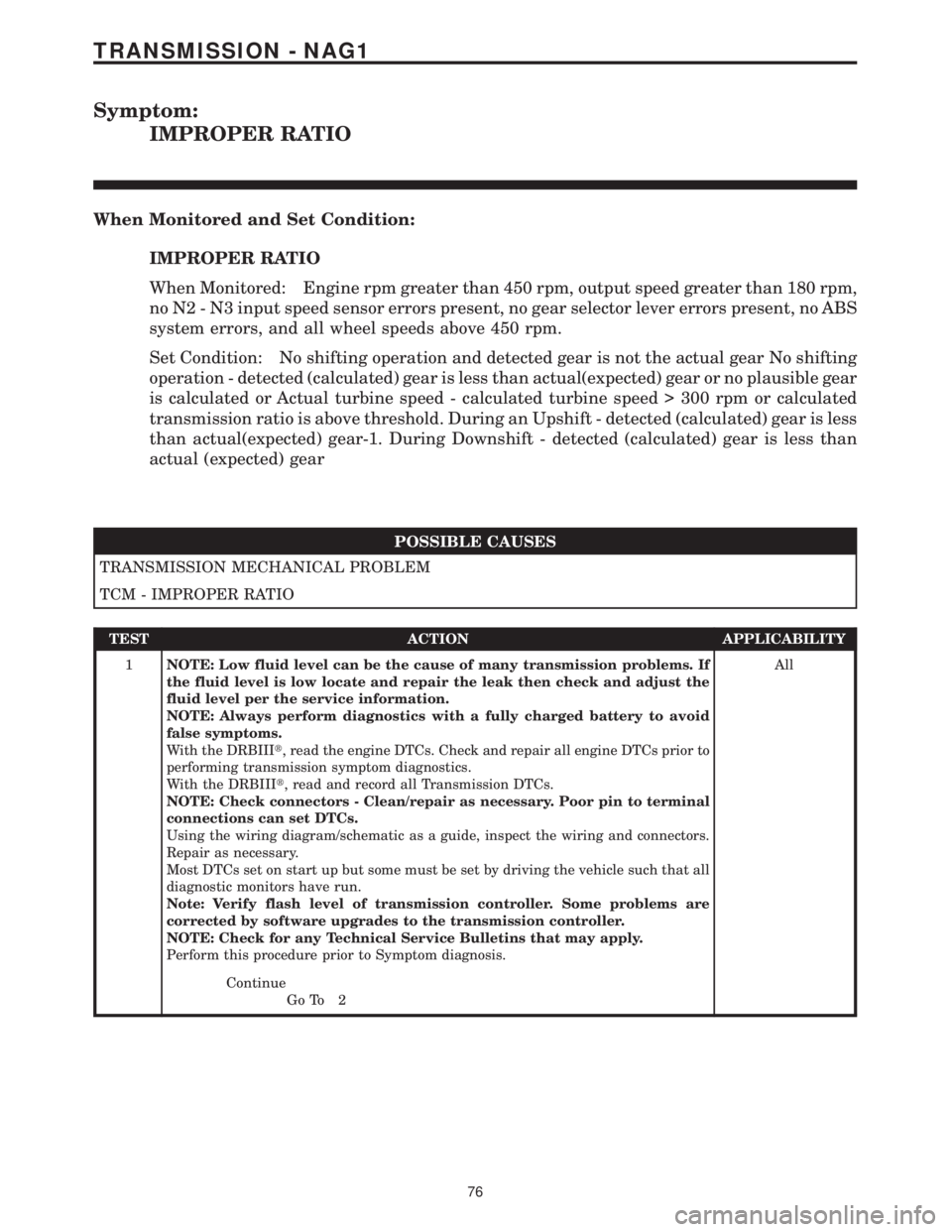
Symptom:
IMPROPER RATIO
When Monitored and Set Condition:
IMPROPER RATIO
When Monitored: Engine rpm greater than 450 rpm, output speed greater than 180 rpm,
no N2 - N3 input speed sensor errors present, no gear selector lever errors present, no ABS
system errors, and all wheel speeds above 450 rpm.
Set Condition: No shifting operation and detected gear is not the actual gear No shifting
operation - detected (calculated) gear is less than actual(expected) gear or no plausible gear
is calculated or Actual turbine speed - calculated turbine speed > 300 rpm or calculated
transmission ratio is above threshold. During an Upshift - detected (calculated) gear is less
than actual(expected) gear-1. During Downshift - detected (calculated) gear is less than
actual (expected) gear
POSSIBLE CAUSES
TRANSMISSION MECHANICAL PROBLEM
TCM - IMPROPER RATIO
TEST ACTION APPLICABILITY
1NOTE: Low fluid level can be the cause of many transmission problems. If
the fluid level is low locate and repair the leak then check and adjust the
fluid level per the service information.
NOTE: Always perform diagnostics with a fully charged battery to avoid
false symptoms.
With the DRBIIIt, read the engine DTCs. Check and repair all engine DTCs prior to
performing transmission symptom diagnostics.
With the DRBIIIt, read and record all Transmission DTCs.
NOTE: Check connectors - Clean/repair as necessary. Poor pin to terminal
connections can set DTCs.
Using the wiring diagram/schematic as a guide, inspect the wiring and connectors.
Repair as necessary.
Most DTCs set on start up but some must be set by driving the vehicle such that all
diagnostic monitors have run.
Note: Verify flash level of transmission controller. Some problems are
corrected by software upgrades to the transmission controller.
NOTE: Check for any Technical Service Bulletins that may apply.
Perform this procedure prior to Symptom diagnosis.All
Continue
Go To 2
76
TRANSMISSION - NAG1
Page 2243 of 2305
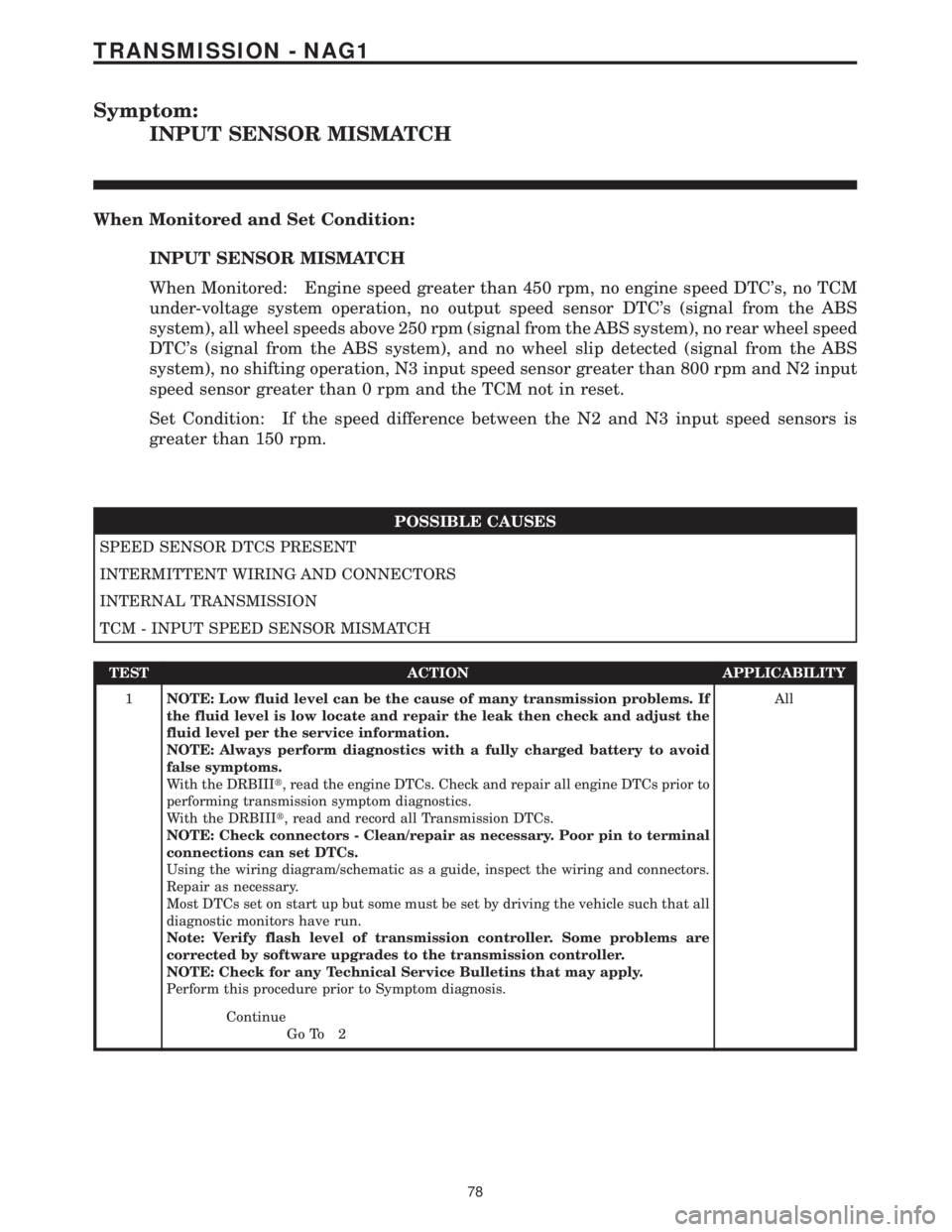
Symptom:
INPUT SENSOR MISMATCH
When Monitored and Set Condition:
INPUT SENSOR MISMATCH
When Monitored: Engine speed greater than 450 rpm, no engine speed DTC's, no TCM
under-voltage system operation, no output speed sensor DTC's (signal from the ABS
system), all wheel speeds above 250 rpm (signal from the ABS system), no rear wheel speed
DTC's (signal from the ABS system), and no wheel slip detected (signal from the ABS
system), no shifting operation, N3 input speed sensor greater than 800 rpm and N2 input
speed sensor greater than 0 rpm and the TCM not in reset.
Set Condition: If the speed difference between the N2 and N3 input speed sensors is
greater than 150 rpm.
POSSIBLE CAUSES
SPEED SENSOR DTCS PRESENT
INTERMITTENT WIRING AND CONNECTORS
INTERNAL TRANSMISSION
TCM - INPUT SPEED SENSOR MISMATCH
TEST ACTION APPLICABILITY
1NOTE: Low fluid level can be the cause of many transmission problems. If
the fluid level is low locate and repair the leak then check and adjust the
fluid level per the service information.
NOTE: Always perform diagnostics with a fully charged battery to avoid
false symptoms.
With the DRBIIIt, read the engine DTCs. Check and repair all engine DTCs prior to
performing transmission symptom diagnostics.
With the DRBIIIt, read and record all Transmission DTCs.
NOTE: Check connectors - Clean/repair as necessary. Poor pin to terminal
connections can set DTCs.
Using the wiring diagram/schematic as a guide, inspect the wiring and connectors.
Repair as necessary.
Most DTCs set on start up but some must be set by driving the vehicle such that all
diagnostic monitors have run.
Note: Verify flash level of transmission controller. Some problems are
corrected by software upgrades to the transmission controller.
NOTE: Check for any Technical Service Bulletins that may apply.
Perform this procedure prior to Symptom diagnosis.All
Continue
Go To 2
78
TRANSMISSION - NAG1
Page 2245 of 2305
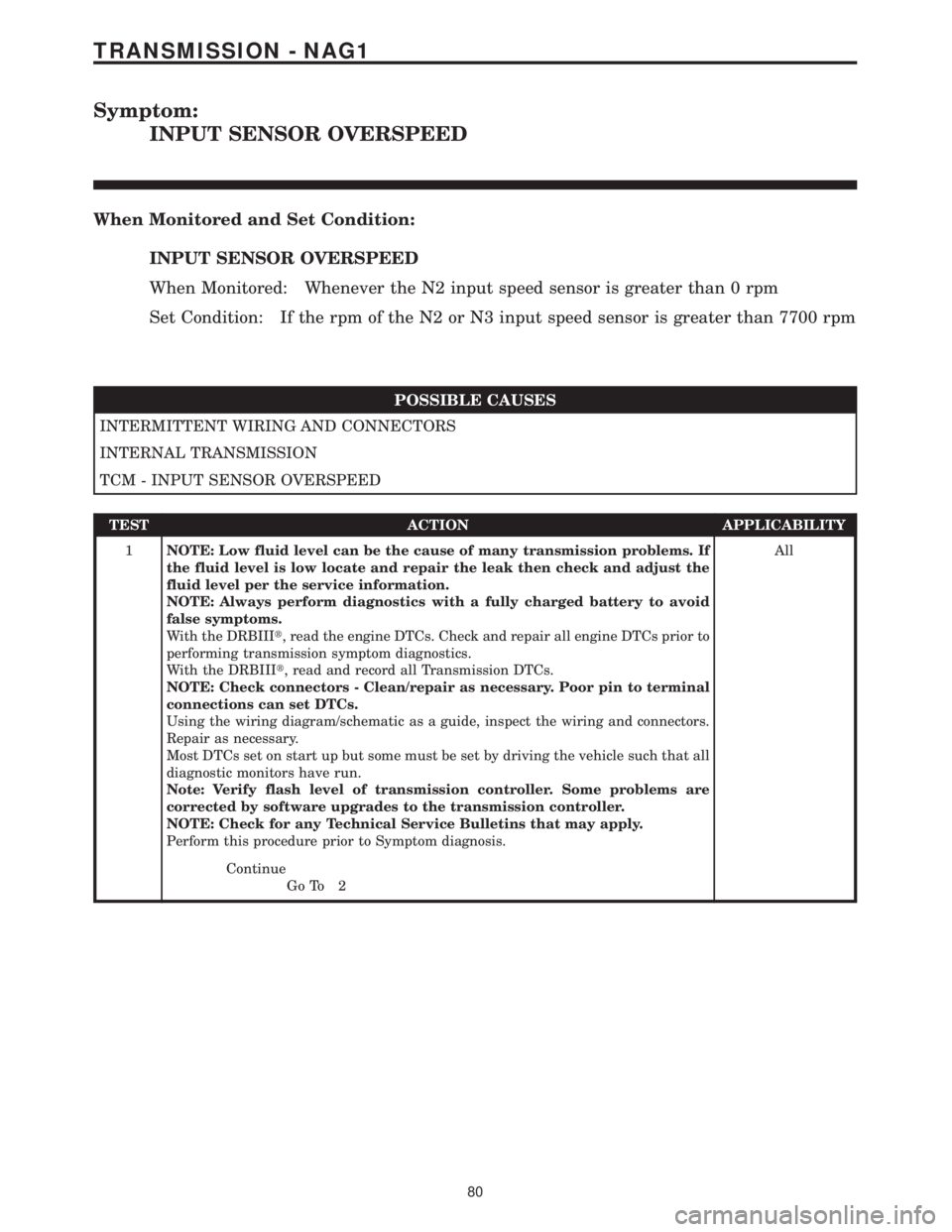
Symptom:
INPUT SENSOR OVERSPEED
When Monitored and Set Condition:
INPUT SENSOR OVERSPEED
When Monitored: Whenever the N2 input speed sensor is greater than 0 rpm
Set Condition: If the rpm of the N2 or N3 input speed sensor is greater than 7700 rpm
POSSIBLE CAUSES
INTERMITTENT WIRING AND CONNECTORS
INTERNAL TRANSMISSION
TCM - INPUT SENSOR OVERSPEED
TEST ACTION APPLICABILITY
1NOTE: Low fluid level can be the cause of many transmission problems. If
the fluid level is low locate and repair the leak then check and adjust the
fluid level per the service information.
NOTE: Always perform diagnostics with a fully charged battery to avoid
false symptoms.
With the DRBIIIt, read the engine DTCs. Check and repair all engine DTCs prior to
performing transmission symptom diagnostics.
With the DRBIIIt, read and record all Transmission DTCs.
NOTE: Check connectors - Clean/repair as necessary. Poor pin to terminal
connections can set DTCs.
Using the wiring diagram/schematic as a guide, inspect the wiring and connectors.
Repair as necessary.
Most DTCs set on start up but some must be set by driving the vehicle such that all
diagnostic monitors have run.
Note: Verify flash level of transmission controller. Some problems are
corrected by software upgrades to the transmission controller.
NOTE: Check for any Technical Service Bulletins that may apply.
Perform this procedure prior to Symptom diagnosis.All
Continue
Go To 2
80
TRANSMISSION - NAG1
Page 2248 of 2305
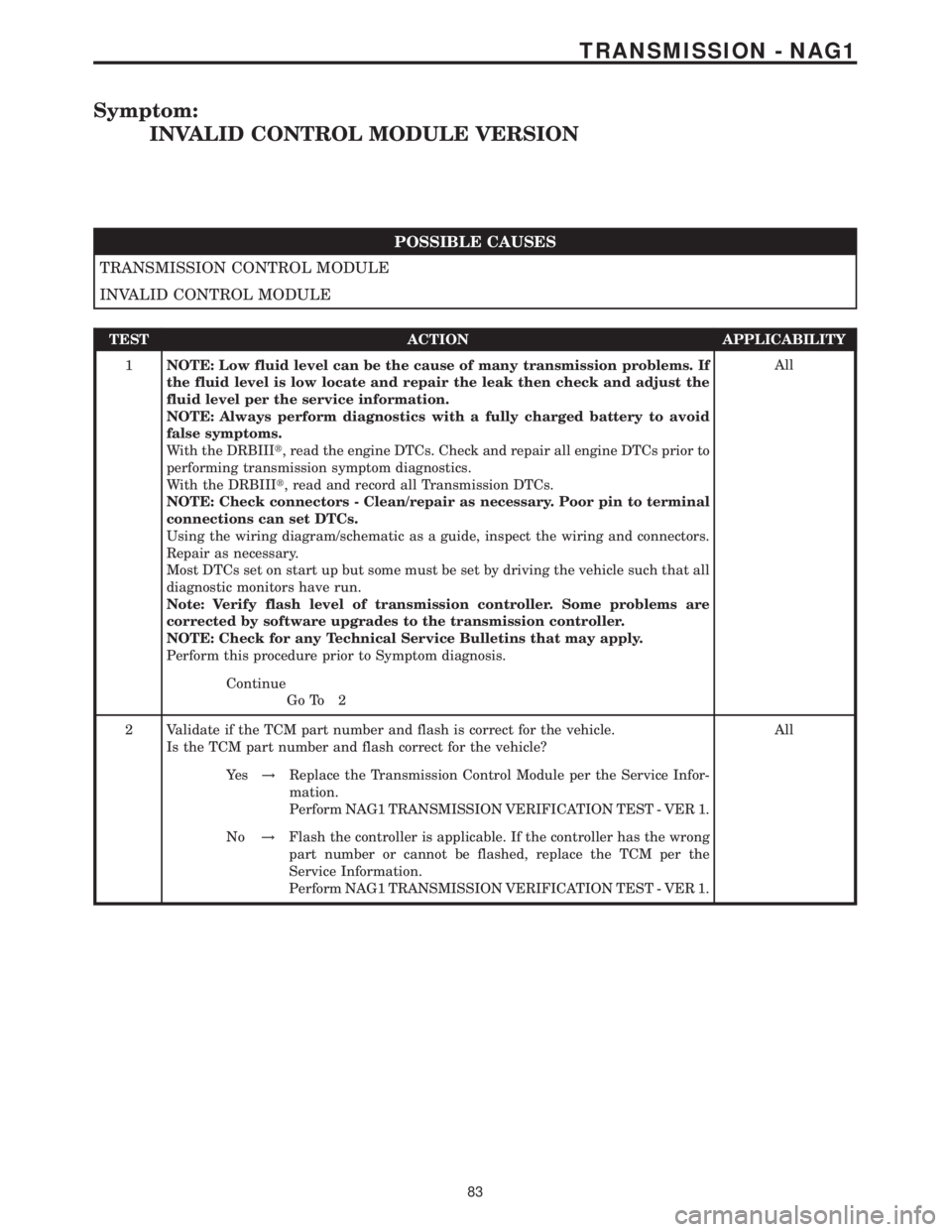
Symptom:
INVALID CONTROL MODULE VERSION
POSSIBLE CAUSES
TRANSMISSION CONTROL MODULE
INVALID CONTROL MODULE
TEST ACTION APPLICABILITY
1NOTE: Low fluid level can be the cause of many transmission problems. If
the fluid level is low locate and repair the leak then check and adjust the
fluid level per the service information.
NOTE: Always perform diagnostics with a fully charged battery to avoid
false symptoms.
With the DRBIIIt, read the engine DTCs. Check and repair all engine DTCs prior to
performing transmission symptom diagnostics.
With the DRBIIIt, read and record all Transmission DTCs.
NOTE: Check connectors - Clean/repair as necessary. Poor pin to terminal
connections can set DTCs.
Using the wiring diagram/schematic as a guide, inspect the wiring and connectors.
Repair as necessary.
Most DTCs set on start up but some must be set by driving the vehicle such that all
diagnostic monitors have run.
Note: Verify flash level of transmission controller. Some problems are
corrected by software upgrades to the transmission controller.
NOTE: Check for any Technical Service Bulletins that may apply.
Perform this procedure prior to Symptom diagnosis.All
Continue
Go To 2
2 Validate if the TCM part number and flash is correct for the vehicle.
Is the TCM part number and flash correct for the vehicle?All
Ye s!Replace the Transmission Control Module per the Service Infor-
mation.
Perform NAG1 TRANSMISSION VERIFICATION TEST - VER 1.
No!Flash the controller is applicable. If the controller has the wrong
part number or cannot be flashed, replace the TCM per the
Service Information.
Perform NAG1 TRANSMISSION VERIFICATION TEST - VER 1.
83
TRANSMISSION - NAG1
Page 2249 of 2305
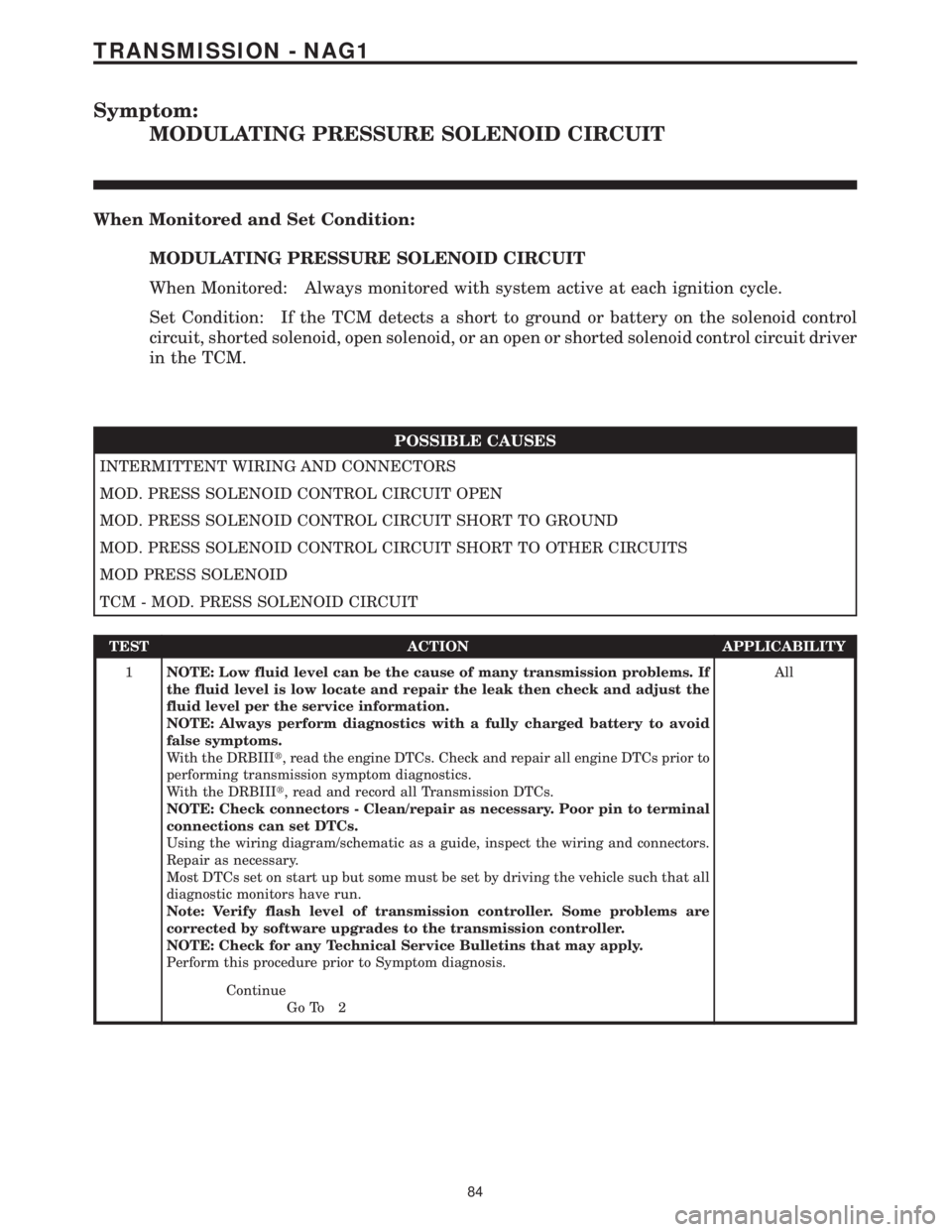
Symptom:
MODULATING PRESSURE SOLENOID CIRCUIT
When Monitored and Set Condition:
MODULATING PRESSURE SOLENOID CIRCUIT
When Monitored: Always monitored with system active at each ignition cycle.
Set Condition: If the TCM detects a short to ground or battery on the solenoid control
circuit, shorted solenoid, open solenoid, or an open or shorted solenoid control circuit driver
in the TCM.
POSSIBLE CAUSES
INTERMITTENT WIRING AND CONNECTORS
MOD. PRESS SOLENOID CONTROL CIRCUIT OPEN
MOD. PRESS SOLENOID CONTROL CIRCUIT SHORT TO GROUND
MOD. PRESS SOLENOID CONTROL CIRCUIT SHORT TO OTHER CIRCUITS
MOD PRESS SOLENOID
TCM - MOD. PRESS SOLENOID CIRCUIT
TEST ACTION APPLICABILITY
1NOTE: Low fluid level can be the cause of many transmission problems. If
the fluid level is low locate and repair the leak then check and adjust the
fluid level per the service information.
NOTE: Always perform diagnostics with a fully charged battery to avoid
false symptoms.
With the DRBIIIt, read the engine DTCs. Check and repair all engine DTCs prior to
performing transmission symptom diagnostics.
With the DRBIIIt, read and record all Transmission DTCs.
NOTE: Check connectors - Clean/repair as necessary. Poor pin to terminal
connections can set DTCs.
Using the wiring diagram/schematic as a guide, inspect the wiring and connectors.
Repair as necessary.
Most DTCs set on start up but some must be set by driving the vehicle such that all
diagnostic monitors have run.
Note: Verify flash level of transmission controller. Some problems are
corrected by software upgrades to the transmission controller.
NOTE: Check for any Technical Service Bulletins that may apply.
Perform this procedure prior to Symptom diagnosis.All
Continue
Go To 2
84
TRANSMISSION - NAG1
Page 2253 of 2305

TEST ACTION APPLICABILITY
1NOTE: Low fluid level can be the cause of many transmission problems. If
the fluid level is low locate and repair the leak then check and adjust the
fluid level per the service information.
NOTE: Always perform diagnostics with a fully charged battery to avoid
false symptoms.
With the DRBIIIt, read the engine DTCs. Check and repair all engine DTCs prior to
performing transmission symptom diagnostics.
With the DRBIIIt, read and record all Transmission DTCs.
NOTE: Check connectors - Clean/repair as necessary. Poor pin to terminal
connections can set DTCs.
Using the wiring diagram/schematic as a guide, inspect the wiring and connectors.
Repair as necessary.
Most DTCs set on start up but some must be set by driving the vehicle such that all
diagnostic monitors have run.
Note: Verify flash level of transmission controller. Some problems are
corrected by software upgrades to the transmission controller.
NOTE: Check for any Technical Service Bulletins that may apply.
Perform this procedure prior to Symptom diagnosis.All
Continue
Go To 2
2 Turn the ignition off to the lock position.
Disconnect the TCM C2 harness connector.
Disconnect the Transmission Solenoid harness connector.
NOTE: Check connectors - Clean/repair as necessary.
Measure the resistance of the Sensor Supply Voltage circuit between the TCM
connector and the Transmission Solenoid Assembly connector
Is the resistance above 5.0 ohms?All
Ye s!Repair the Sensor Supply Voltage circuit for an open.
Perform NAG1 TRANSMISSION VERIFICATION TEST - VER 1.
No!Go To 3
3 With the DRBIIIt, read DTCs.
NOTE: The vehicle must be driven to at least 32 Km/h (20 MPH) for this DTC
to be displayed as active.
Is the Warm up counter displayed and equal to 0?All
Ye s!Go To 4
No!Go To 12
4 Turn the ignition switch to the lock position
Disconnect the TCM C2 harness connector.
Disconnect the Transmission Solenoid Assembly harness connector.
Note: Check connectors - Clean/repair as necessary.
Measure the resistance of the N2 Input Speed Sensor Signal circuit from the TCM
connector to the Transmission Solenoid Assembly connector.
Is the resistance above 5.0 ohms?All
Ye s!Repair the N2 Input Speed Sensor Signal circuit for an open.
Perform NAG1 TRANSMISSION VERIFICATION TEST - VER 1.
No!Go To 5
88
TRANSMISSION - NAG1
N2 INPUT SPEED SENSOR CIRCUIT ÐContinued
Page 2257 of 2305
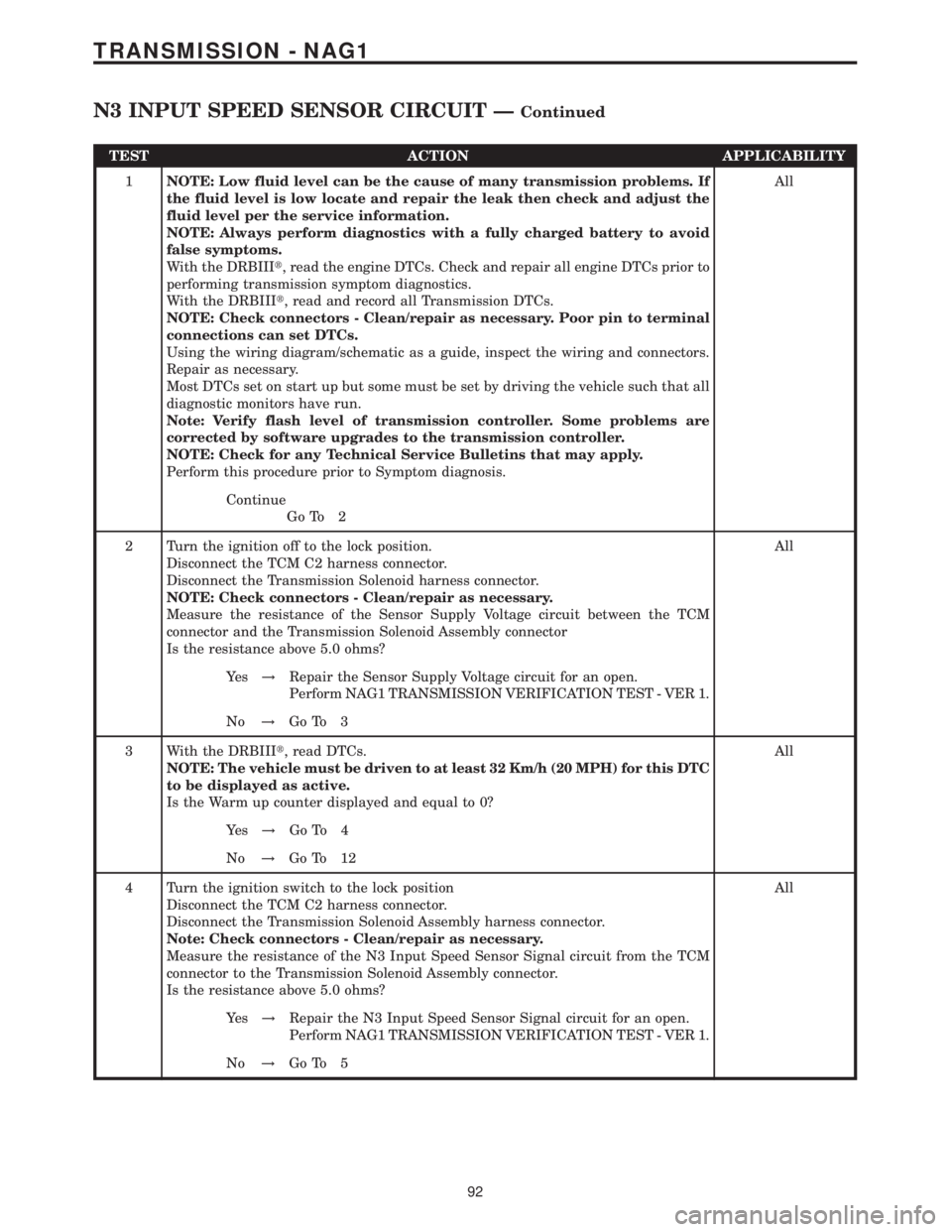
TEST ACTION APPLICABILITY
1NOTE: Low fluid level can be the cause of many transmission problems. If
the fluid level is low locate and repair the leak then check and adjust the
fluid level per the service information.
NOTE: Always perform diagnostics with a fully charged battery to avoid
false symptoms.
With the DRBIIIt, read the engine DTCs. Check and repair all engine DTCs prior to
performing transmission symptom diagnostics.
With the DRBIIIt, read and record all Transmission DTCs.
NOTE: Check connectors - Clean/repair as necessary. Poor pin to terminal
connections can set DTCs.
Using the wiring diagram/schematic as a guide, inspect the wiring and connectors.
Repair as necessary.
Most DTCs set on start up but some must be set by driving the vehicle such that all
diagnostic monitors have run.
Note: Verify flash level of transmission controller. Some problems are
corrected by software upgrades to the transmission controller.
NOTE: Check for any Technical Service Bulletins that may apply.
Perform this procedure prior to Symptom diagnosis.All
Continue
Go To 2
2 Turn the ignition off to the lock position.
Disconnect the TCM C2 harness connector.
Disconnect the Transmission Solenoid harness connector.
NOTE: Check connectors - Clean/repair as necessary.
Measure the resistance of the Sensor Supply Voltage circuit between the TCM
connector and the Transmission Solenoid Assembly connector
Is the resistance above 5.0 ohms?All
Ye s!Repair the Sensor Supply Voltage circuit for an open.
Perform NAG1 TRANSMISSION VERIFICATION TEST - VER 1.
No!Go To 3
3 With the DRBIIIt, read DTCs.
NOTE: The vehicle must be driven to at least 32 Km/h (20 MPH) for this DTC
to be displayed as active.
Is the Warm up counter displayed and equal to 0?All
Ye s!Go To 4
No!Go To 12
4 Turn the ignition switch to the lock position
Disconnect the TCM C2 harness connector.
Disconnect the Transmission Solenoid Assembly harness connector.
Note: Check connectors - Clean/repair as necessary.
Measure the resistance of the N3 Input Speed Sensor Signal circuit from the TCM
connector to the Transmission Solenoid Assembly connector.
Is the resistance above 5.0 ohms?All
Ye s!Repair the N3 Input Speed Sensor Signal circuit for an open.
Perform NAG1 TRANSMISSION VERIFICATION TEST - VER 1.
No!Go To 5
92
TRANSMISSION - NAG1
N3 INPUT SPEED SENSOR CIRCUIT ÐContinued
Page 2260 of 2305
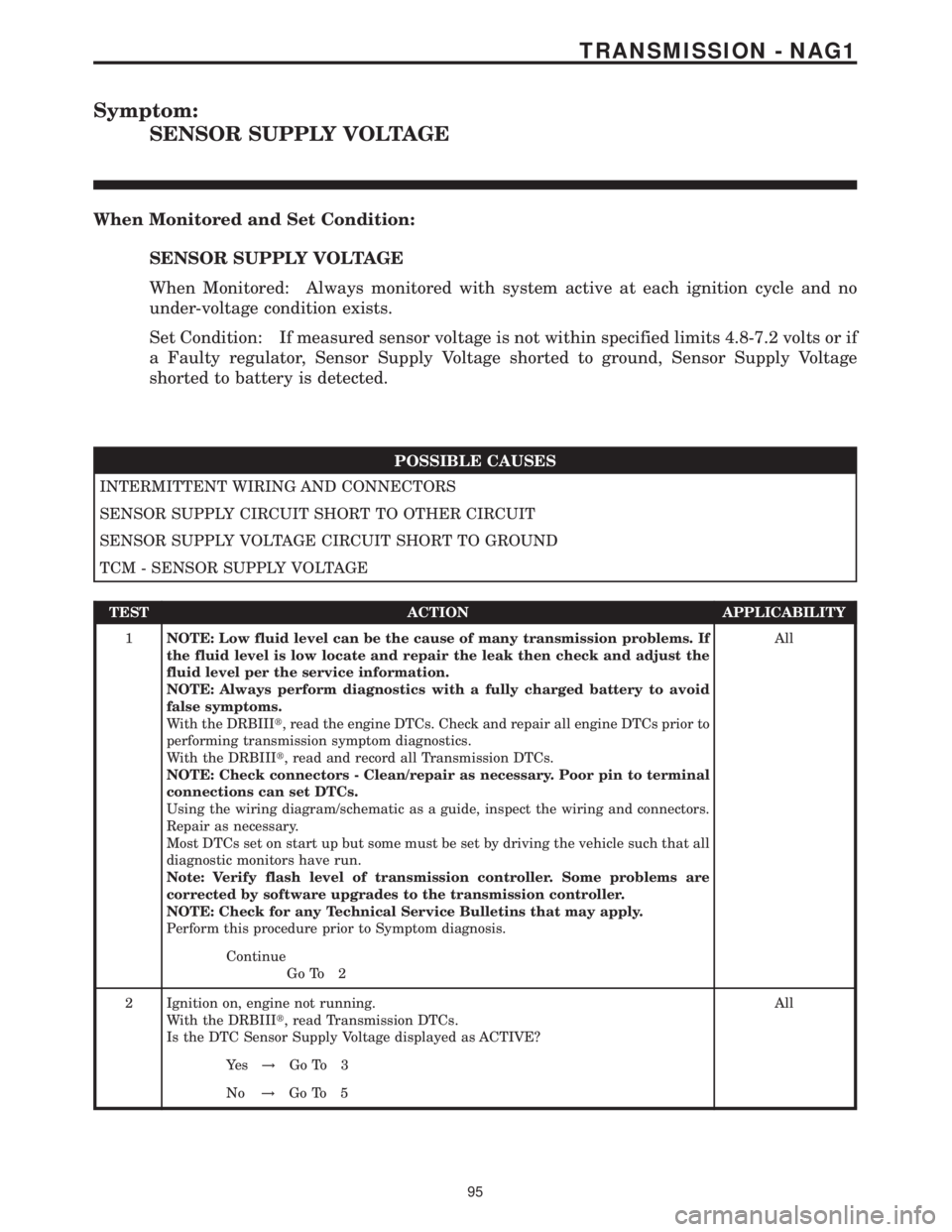
Symptom:
SENSOR SUPPLY VOLTAGE
When Monitored and Set Condition:
SENSOR SUPPLY VOLTAGE
When Monitored: Always monitored with system active at each ignition cycle and no
under-voltage condition exists.
Set Condition: If measured sensor voltage is not within specified limits 4.8-7.2 volts or if
a Faulty regulator, Sensor Supply Voltage shorted to ground, Sensor Supply Voltage
shorted to battery is detected.
POSSIBLE CAUSES
INTERMITTENT WIRING AND CONNECTORS
SENSOR SUPPLY CIRCUIT SHORT TO OTHER CIRCUIT
SENSOR SUPPLY VOLTAGE CIRCUIT SHORT TO GROUND
TCM - SENSOR SUPPLY VOLTAGE
TEST ACTION APPLICABILITY
1NOTE: Low fluid level can be the cause of many transmission problems. If
the fluid level is low locate and repair the leak then check and adjust the
fluid level per the service information.
NOTE: Always perform diagnostics with a fully charged battery to avoid
false symptoms.
With the DRBIIIt, read the engine DTCs. Check and repair all engine DTCs prior to
performing transmission symptom diagnostics.
With the DRBIIIt, read and record all Transmission DTCs.
NOTE: Check connectors - Clean/repair as necessary. Poor pin to terminal
connections can set DTCs.
Using the wiring diagram/schematic as a guide, inspect the wiring and connectors.
Repair as necessary.
Most DTCs set on start up but some must be set by driving the vehicle such that all
diagnostic monitors have run.
Note: Verify flash level of transmission controller. Some problems are
corrected by software upgrades to the transmission controller.
NOTE: Check for any Technical Service Bulletins that may apply.
Perform this procedure prior to Symptom diagnosis.All
Continue
Go To 2
2 Ignition on, engine not running.
With the DRBIIIt, read Transmission DTCs.
Is the DTC Sensor Supply Voltage displayed as ACTIVE?All
Ye s!Go To 3
No!Go To 5
95
TRANSMISSION - NAG1